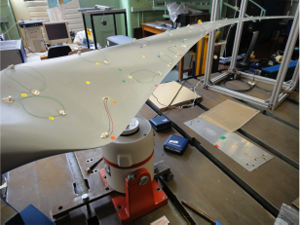Relationship to other projects/themes
The purpose of this theme is to coordinate activities across the ENL project. It has been introduced to provide a clear structure for achieving the overall objectives of the ENL project by coordinating activities across the other five themes.
Aims
To coordinate activities from Themes 1 to 5 such that the overall objectives of the ENL project are achieved.
CA1: demonstration

Figure 1: Wind turbine blade experiment
The primary purpose of the demonstrators, stated in the original proposal was to validate new techniques against experimental results from industrially inspired experimental demonstrator rigs. The new techniques are those developed in Themes 1 to 5 to address the overall project objectives. The demonstrators are experimental rigs that are industrially inspired. They are not intended to operate at high TRL levels, but rather are intended as a first level validation of the new ideas generated in the project. Progressing the ideas into higher TRL levels in collaboration with industrial partners is facilitated separately. The four technology demonstrators have the following current status.
D1 update
This demonstrator is a small scale flexible wind turbine blade structure exactly as originally planned in the proposal. The rig is based at the University of Sheffield and is shown in Figure 1. The aim of this demonstrator is to show how the machine learning identification algorithms being developed in Theme 1 can be applied in practice. This is discussed in WP 1.2.
D2 update
The original plan for D2 was to use a mod ified version of a gearbox apparatus at the University of Bristol. However, after discussions with industrial partners (particularly at the harsh nonlinearity workshop in 2013) it became clear that a gear rattle rig would not be particularly valuable as a demonstrator. As a result the MC decided to focus on using the friction rig instead. This rig is based at the University of Cambridge and is discussed in WP 2.2. This will be used to demonstrate the effectiveness of the new friction modelling techniques being developed in Themes 2 and 4. D3 Update: This demonstrator is similar to that planned in the original proposal. Namely a ground vibration test using a scale model of a flexible aircraft structure. Currently, the rig based at University of Bristol has been is an engine store model with a localised nonlinearity where the engine stores join the wing. Details in WP 3.2. D4 Update: This demonstrator has been changed. It was stated in the original proposal that “D4 is more high risk and adventurous”, and after consideration the Management Committee has decided to replace the original D4 with a new, lower risk, demonstrator. The new demonstrator is the vibration based energy harvester system described in Annex Theme 5. The aim of the demonstrator is to show how passive and active control techniques can be exploited using techniques being developed in Theme 5.
CA2: classification
One of the key problems to arise in practice is identifying what type of nonlinearity is present in a particular application. From an identification perspective this is a crucial step in the process. In fact this problem is being addressed using an ontological approach in WP 1.3 of Theme 1. More broadly the issue of classification is an important process. For example in both modelling and control, there are broad categories of nonlinear phenomena that can be tackled with techniques that are specific to the type of nonlinearity itself. In addition to the work going on in Themes 1-5, there are two main activities: 1.Led by Jim Woodhouse & Tore Butlin, a group of researchers across the ENL programme have been working on producing a classification “guide” to nonlinearity. This work takes the form of a mind map intended to represent and connect the islands inhabited by specialists within the general field of nonlinear structural dynamics, but covering a wide range of perspectives from both academia and industry. 2.Ben Weekes at Bristol has produced a handbook for industrial partners to enable them to deal with nonlinearity in the context of modal testing. See WP 3.2
CA3: knowledge transfer
Wagg, Worden, Jones and Lightfoot form the Project Management Team that meets each week to deal with the day-to-day management of the project. Part of that role is to implement the Management Committee’s plans on knowledge transfer. This works in several ways:
- Lightfoot manages the ENL website, which is a mechanism of disseminating basic information about the project, including an up-to-date list of publications with links to where they can be obtained via open access.
- Jones manages a Sharepoint site that is used as a information repository within the project. All project members and industrial partners have access, including Steering Committee members and the EPSRC representatives overseeing the project.
- Wagg and Jones visit all industry partners at least annually to facilitate knowledge transfer that could be relevant. In addition a series of knowledge transfer workshops are now planned. The first being on Verification & Validation at EDF energy, March 2015. Jones also coordinates all other interaction with industry partners, particularly any potential intellectual property and secondments.
- Lightfoot organises and coordinates visits from academic visitors (listed below). In addition to this the project has strong cross-over into other scientific areas and, for example papers [1-5] indicate the type of outputs investigators are producing that bridge the gap between this project and other activities. The ENL researchers are also contributing to multiple international conferences, as evidenced in the Annexes.